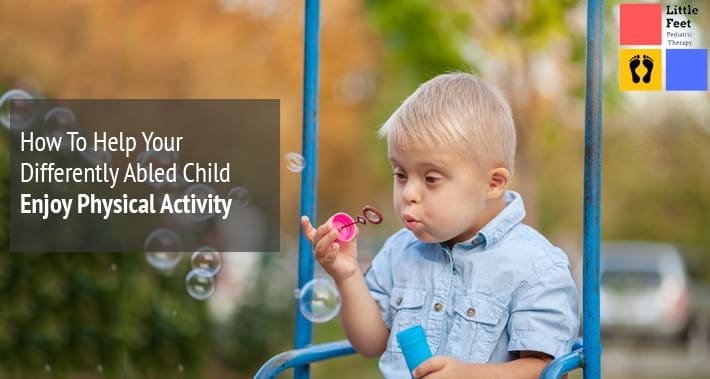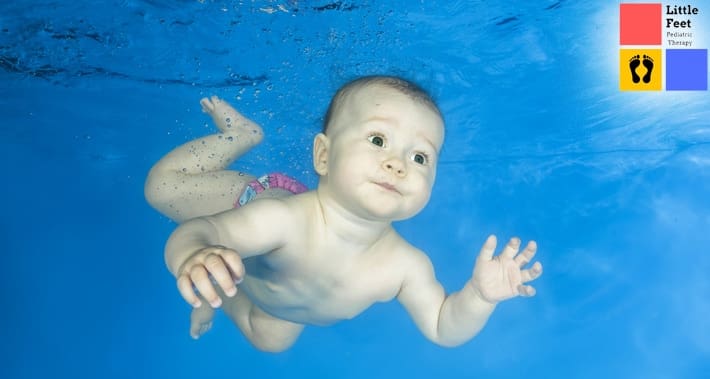
Physical activity is important for everyone for their physical and mental health and overall quality of life.
Children with disabilities also need to be as active as possible, but it can be a little trickier based on their limitations.
But aside from the health benefits, physical activity can help disabled children have fun and foster inclusivity and equality.
Children with physical disabilities may face barriers to being active but there are still ways to help and encourage them.
Here at the Little Feet Pediatric Therapy clinic we want to help give your child the strongest start in life.
To make it easier for you and your child, we offer both mobile pediatric therapy and pediatric teletherapy services that can help.
For today, let’s take a closer look at why physical activity is important and how to help your disabled child stay as active as possible.
Why Is Physical Activity For Kids Important?
Remaining physically active is one of the most important ways you can encourage your child’s development.
It as an incredible number of benefits, including:
- Building their muscles
- Building stronger bones
- Reducing anxiety or depression
- Improving their social skills
- Maintaining a healthy weight
- Promoting cardiovascular health
- Improving their self esteem
- Developing their gross motor skills
- Developing their fine motor skills
- Developing their hand eye coordination
- Encouraging greater independence
- Improving cognitive, emotional, and psychological development
- Decreased risk of many chronic diseases
- Improved overall health
As you can see, encouraging your child to be physically active has numerous benefits and promotes their overall quality of life.
This is just as true for disabled children as it is for anybody else.
But some disabled children may have difficulty with certain physical activities they see their friends doing.
This can cause social isolation and depression, as well as a lack of physical development.
That’s why it’s important as a parent of a disabled child to be proactive.
There’s no reason why you and your disabled child can’t find ways to stay active that are beneficial, enjoyable, and inclusive.
Tips For Helping Your Disabled Child Enjoy Being Active
Having a disabled child may put limitations on their ability to be physically active.
But you can find ways and alternatives to help and encourage them to be as active as possible.
When looking for solutions, Little Feet Therapy is here to help your child through their barriers to build their confidence.
Here are some considerations to keep in mind to give your child the opportunity to enjoy engaging in physical activity.
1. Above All Else, Keep A Positive Attitude
Parents of disabled children are often reminded of their child’s limitations.
Perhaps you enjoyed a certain athletic activity when you were younger that your child just won’t be able to do, for example.
But rather than doubt, hesitation, and fear, it’s important to maintain a positive attitude.
Focusing on your child’s accomplishments rather than limitations can help you motivate them to stay active.
As they explore new movements and activities, they can gain confidence and competence to push themselves to try new things.
Supporting your child and understanding what’s meaningful and enjoyable to them will keep them motivated and excited.
Encouragement is vital to helping disabled children be active and try new things.
After all, it’s supposed to be fun, not a chore.
2. Keep Their Limitations In Mind When Suggesting Activities
Understanding your child’s limitations is important.
Most physical activities can be adapted and tailored to your child’s needs to give them the opportunity to participate.
You may have to modify rules, environments, and equipment, but encourage your child to pursue their interests.
If your child has cerebral palsy, for example, it’s likely they will have difficulty with traditional sports.
However, wheelchair adaptive sports for varying abilities is growing in popularity for kids with cerebral palsy and other disabilities.
On the other hand, if your child has Down syndrome, they may have difficulties with more coordinated movements.
In this case, karate, tae kwon do, dancing, gymnastics, or swimming might be a good place to start.
Children with varying abilities often thrive in individual sports.
This is because they don’t feel like they’re “letting the team down” or in competition with others, but rather setting their own personal goals to accomplish.
Even with individual sports, being part of a class still works on their social skills.
Looking into community sports programs or teams might be helpful as well.
Be mindful to choose a program that doesn’t put too much pressure on your child to perform or they may be turned off by the activity.
Emphasizing fun and participation over skill and competition allows them to try and experience new activities without putting pressure on their ability.
3. Create A Safe, Active Environment At Home
Physical activity doesn’t need to be limited outside the home or to pediatric physical therapy sessions.
You can also create games and activities that incorporate fun and play into physical activity at home.
Incorporating strength and balance activities with slow intensity can keep your children active while avoiding injury.
Things like dancing, a treasure hunt, or catching bubbles can all contribute to your child’s physical activity time.
Having various sports equipment at home encourages the whole family to be active together.
You can also break down exercise and activity into smaller time chunks throughout the day.
By incorporating safe, fun activities at home, you can provide your child with opportunities to explore how their body moves.
4. Let Your Child Take The Lead
If your child seems to enjoy some activities more than others, let them take the lead.
Encourage your child to try various activities until they find ones that they find enjoyable.
Allowing your child to explore different activities will offer new sensory experiences and opportunities for them to get active.
Consider which environment and what type of activities your child enjoys most and pursue the things in which they have fun.
Some children feel more comfortable with other children with similar abilities, whereas others want to participate with children with all abilities.
Allow your child to choose what type of environment and physical activity they want so that they are excited to participate.
5. Celebrate Their Victories
When it comes to physical activity, each child is unique in their abilities and achievements.
Acknowledging and celebrating milestones further encourages them to keep going.
Setting short term goals that allow your child to succeed quickly can motivate their desire to be more active.
Letting your child see their own improvement by measuring their progress and accomplishments further inspires them to continue.
These goals can include things like gaining mastery over a specific skill, developing friendships, or inspiring others.
Celebrating your child’s victories encourages them to continue their activities and challenge themselves to pursue new things.

What Happens When Your Kids Are Inactive?
Since disabled children may face challenges when it comes to physical activity, this can lead them to be less physically active than other children.
An inactive lifestyle can lead to further complications and cause other problems.
Some possible complications from lack of physical activity include:
- Reduced fitness
- Low self esteem
- Reduced bone density
- Poor circulation
- Reduced independence
- Lack of social interactions
- Weight gain
If your child is inactive from a young age, it can lead to delayed development of their gross motor skills as well, which will have long term consequences.
Getting disabled children to be routinely active can help reduce the risk of many of these potential issues.
How Much Physical Activity Do Kids Need?
As a general guideline, it’s a good idea for kids to get between two and three hours of physical activity per week.
Breaking down activities into bite size chunks can help manage their activity levels and keep them staying active.
Book Your Appointment With Little Feet Pediatric Therapy Today
If you have a child with different physical needs, we’re here to help.
Book your appointment with Little Feet Pediatric Therapy today.
► 3535 Randolph Rd, Charlotte, NC 28211
► 1331 H St NW Ste 200, Washington, DC 20005
► St. Louis, MO
► Raleigh, NC
Founded in 2019, Little Feet Therapy offers on site pediatric physical and occupational therapy treatments for children from 2 months to 18 years old with physical and developmental concerns. Our clinics focus on providing therapy in a child’s natural setting where your child is in familiar surroundings, it puts their mind at ease and helps them focus more on the work they’re doing with their pediatric therapist. Our therapists will work with your child at your home, at school, at daycare, or another place in the community where they feel most comfortable.